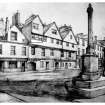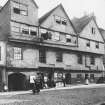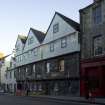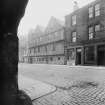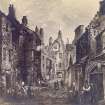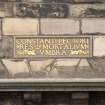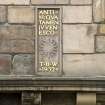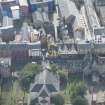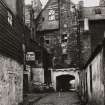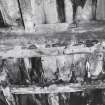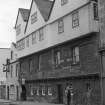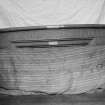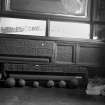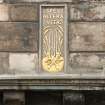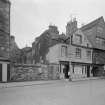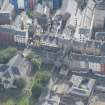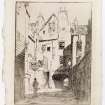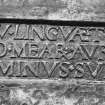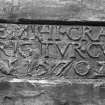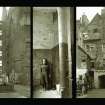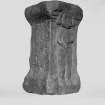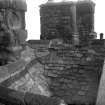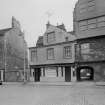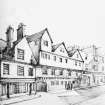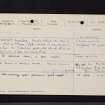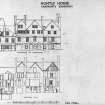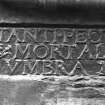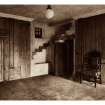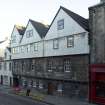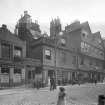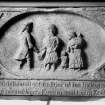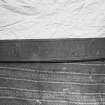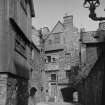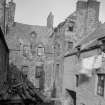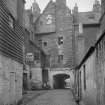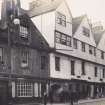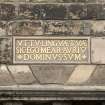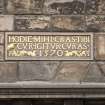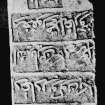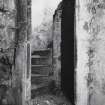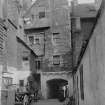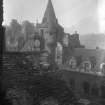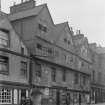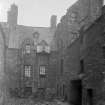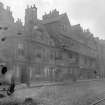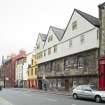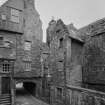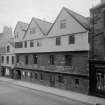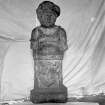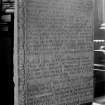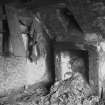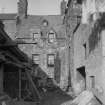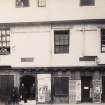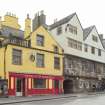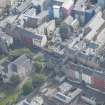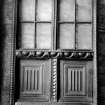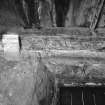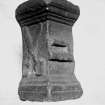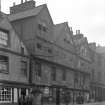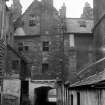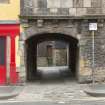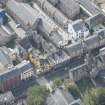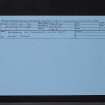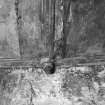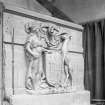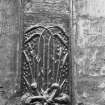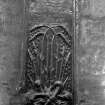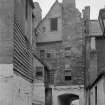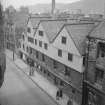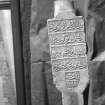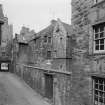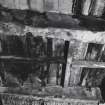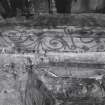Edinburgh, 146 Canongate, Huntly House
House (16th Century), Museum (20th Century), Tenement (16th Century)
Site Name Edinburgh, 146 Canongate, Huntly House
Classification House (16th Century), Museum (20th Century), Tenement (16th Century)
Alternative Name(s) Huntly House Museum; Bakehouse Close; 142, 152, 154 Canongate; Acheson Court; Slater's Court
Canmore ID 52526
Site Number NT27SE 61
NGR NT 26435 73773
Datum OSGB36 - NGR
Permalink http://canmore.org.uk/site/52526
- Council Edinburgh, City Of
- Parish Edinburgh (Edinburgh, City Of)
- Former Region Lothian
- Former District City Of Edinburgh
- Former County Midlothian
NT27SE 61 26439 73768.
(NT 2643 7377) Huntly House: Erroneously identified as the "lodging" of George, 6th Earl and 1st Marquess of Huntly (1576-1636) and consequently known as Huntly House. It is a dwelling-house, probably erected in the early 16th century and renovated in 1570 and further again during the 17th century.
RCAHMS 1951.
As described above; in good condition.
Visited by OS (J D) 26 December 1953.
Still known as 'Huntly House.' Now a museum.
Visited by OS 8 February 1954; Information from R F Landon, City Architect's Office, Edinburgh.
No change from previous field report
Visited by OS (S F S) 2 December 1975.
Depicted on the coloured 1st edition of the O.S. 1:1056 scale map (Edinburgh and its Environs, 1854, sheet 30).
See also: "Romantic Edinburgh" by Lewis Spence
NMRS Print Room
154 Canongate
1 exterior
11 different interior views (1 duplicated - 12 prints)
Inglis Photograph Collection
Acc No 1994/90
REFERENCE:
National Library: Country Life, April 7th 1934
REFERENCE:
Sources: Dean of Guild. Bundle 1807. January-May. 5.3.1807.
Pet. of Alexander Munro, builder in Ed.
Huntly House.
Small alterations - window converted to door with stairs to first flat.
Plans & elevations - unsigned. [1807. P.O. Directory. alex Munro, Builder, opp.
Canongate Church].
NT27SE 61.01 26436 73761 Sundial
Publication Account (1951)
104. Huntly House, 146 Canongate.
Through a wholly erroneous tradition this ancient house has been identified as the “lodging” of George, sixth Earl and first Marquess of Huntly (1576-1636), and has consequently come to be known as Huntly House, whereas its connection with the Huntly family was of much later date and only of short duration. It was not until about the middle of the18th century that the Dowager Duchess of Gordon rented one part of the property from the Incorporation of Hammermen of the Canongate, who had owned it since 1647, and on removing she was succeeded in the tenancy by her son, Lord AdamGordon. (1) In 1924, when threatened with destruction, the house was purchased by the municipality, which is to be heartily commended for the manner in which it has restored the fabric and put it to practical use as the City Museum. The building is roughly T-shaped, having a main block which faces N. towards the street and contains beneath its E. end the entry to Bakehouse Close, and a long, low extension running southwards between the Close and a " yard "or garden which lies parallel to it on the W. During the latter part of the 18th century the Incorporation of Bakers became proprietors of the southern most part of the property, where they built a bakehouse, and the Close thereupon became known by its present name. The fabric as a whole shows every indication of extensive alteration, but since the early titles have disappeared some of the stages in its development remain in doubt. In the official guidebook, Sir Frank Mears, P.R.S.A., F.R.I.B.A., who directed the restoration, gives it as his opinion that" The property originally consisted of three narrow garden strips.* At the Canongate end of each of these strips was a small dwelling with a gateway at the side or below, opening into the garden or close behind. These dwellings were probably originally constructed of timber, replaced by stone during the16th century, perhaps after the destruction of the town by the English forces in 1544.” A row of three such houses is certainly still traceable in the present "complex," the one in the middle extending a little farther S. than its neighbours, and all three standing back about 10 ft. from the present frontage line. Of their arrangement little can be said, except that there does not seem to have been direct communication between the ground floors and those above, as the first floors were approached by forestairs and the further ascent was taken up thence by internal newel-stairs. The fronts were no doubt screened by wooden galleries.
A later stage of development saw the three small buildings united and the block so formed brought forward to the present frontage. The building of anew front for the whole was thus entailed. A vaulted pend was now driven through the ground floor of the easternmost house to give access to a close behind, and for some reason the back wall of this house was partly taken down and rebuilt. That work, together with some internal reconstruction, can be referred to the year 1570. The front building was now two storeys and an attic in height, the lower part of the facade being of rubble with ashlar dressings while the upper part, which was set out on separate moulded corbels, was wholly of ashlar. The first-floor windows rose above the moulded eaves-course and were pedimented. From the roof projected a row of storm-windows. So far the front building stood detached, but at about this time it appears to have been extended S. from the projecting gable of the central unit, in a building intended to provide more adequate kitchen-premises. Of this extension, which consisted of a single storey with a loft, the only surviving trace is a large fireplace containing in one jamb the customary receptacle for salt. The family of Acheson, who had owned the property since 1517, sold it in 1609 to William Sharp of Ballendoch (2), with whom and with whose heirs it remained until 1647. Some improvements were effected, no doubt between these dates. The S. part of the central unit, for instance, looks as if it had been raised in height at about that time, while the present back windows of the W. unit cannot well be earlier. In 1647 the house was purchased by the Incorporation of Hammermen, mainly as an investment for their accumulated funds but also to provide a meeting place for the Craft. In the following year other repairs and alterations were begun. First of all a convening-house was contrived above the kitchen by the throwing of two lofts into one, and three months later the remainder of the S. range was reconstructed. The main block, or "fore lodging," as it was called, was now let; and in 1671 the Incorporation, wishing to increase the accommodation available for letting, called in "Mr. Mylne, the King's Master Mason," to consult with their own masons and wrights in devising a scheme to this end. The solution at which they arrived is probably to be seen in the existing gabled superstructure, or part of it, that is set out on both sides of the main block; and it is further on record that the E. newel-stair, or turnpike, was to be improved and provided with a "skelliestair." If by the latter term is meant, as is probable, a scale-stair, this stair still exists as the access to the turnpike and is approached from the Close by a short forestair with moulded copings, and through a handsome doorpiece of this time which stands at its head. When the Hammermen finally disposed of the property in 1762 there were no fewer than seventeen tenants in the place, varying in station from craftsmen at one end of the scale to a merchant and Lord Adam Gordon at the other.
As it now stands, the front has a segmented archway at the outer end of the vaulted transe that gives entry to Bakehouse Close. Immediately W. of this, on the ground floor, are three windows which have been renewed. Two others, flanking a doorway beyond, can be referred to 1570 on the evidence of the mouldings wrought on all three openings; while a built-up window, as well as a smaller one farther W., which is still open, are simply chamfered at the arrises and may therefore be somewhat later in date. The first floor, rising from a tier of moulded corbels surmounted by a moulded cornice, has five windows of which the easternmost but one looks like an insertion. Between the sills and the cornice is a series of panels, bearing inscriptions in addition to being carved and gilt. The easternmost of these has been introduced to commemorate the recent restoration, and the other four are replicas of the original panels which have been placed inside for preservation.
[see RCAHMS 1951, pp. 168-174 for a full architectural description and a note on 23 architectural fragments then held in the museum]
RCAHMS 1951
(1) O.E.C., xiv, pp. 1-5 and xx, pp. 78 f. (2) Ibid., xiv, p.3
Watching Brief (September 1998)
NT 2644 7377 A watching brief was carried out in September 1998 on a hole excavated by contractors to insert a roof support beam in the kitchen area of Huntly House to the W of the pend of Bakehouse Close, Canongate. A subsoil of compact clayey sand with some flecks of coal and chips of whinstone was found at a depth of 0.3m below the floor surface (limit of excavation). This deposit appeared to overlie an outcrop of whinstone bedrock, and contained no datable finds.
Sponsor: Edinburgh City Museums.
D Henderson 1999
Trial Trench (4 August 2014 - 8 August 2014)
A trial trench evaluation comprising three hand excavated test pits along the length of the courtyard to the rear of Huntly House recorded a limited number of features. Below the west property boundary wall in Trench 3 a midden pit was found containing fragments of glazed and unglazed Scottish White Gritty Ware pottery this is likely to date from the medieval period and may be associated with an earlier layout of property boundaries. A putative kerb or paving remnant and post-hole recorded in Trench 2 may be associated with more recent activity on the site. Shallow make-up deposits were found overlying natural towards the north end of the site and buried garden soils survived to the south end of the site.
Information from Alan Hunter Blair (GUARD Archaeology Limited) 30 October 2014. OASIS ID: guardarc1-192835
























































































